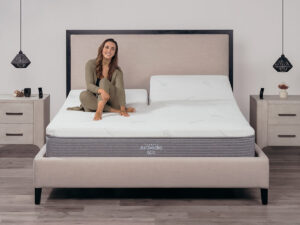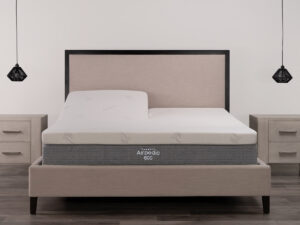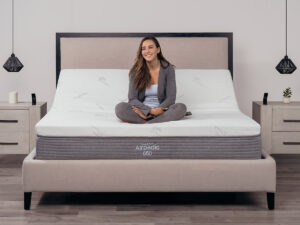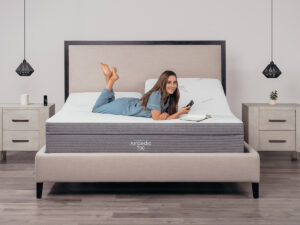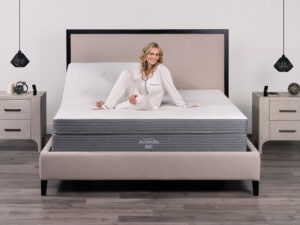Best Mattress for Sciatica
The 4 Best Mattresses for Sciatica Pain
Sufferers of sciatica know all too well the impact the condition has on their quality of sleep. Sciatica affects millions of people, particularly older adults, and the associated sharp pains that shoot through your lower back, hips, or legs often worsen at night. This makes finding the right mattress critical to managing sciatic pain and, in turn, improving sleep quality. While the wrong sleep surface can exacerbate symptoms, the right one can offer significant relief from sciatica pain.
At Airpedic™, we’ve spent over two decades studying how proper body support and spinal alignment affect orthopedic conditions like sciatica. Our research into medically informed mattress designs and adjustable air mattresses has revealed which features truly impact pain relief. This guide helps you identify the best mattress for sciatica by exploring the four best mattress types for the condition and how their various materials and support systems can contribute to improved sleep and reduced discomfort.
1. Adjustable Air Beds
Featured products
-
Airpedic® 500
Select OptionsPrice range: $2,399 through $3,949 -
Airpedic® 600
Select OptionsPrice range: $1,739 through $2,789 -
Airpedic® 650
Select OptionsPrice range: $3,299 through $5,299 -
Airpedic® 700
Select OptionsPrice range: $3,299 through $5,599 -
Airpedic® 800
Select OptionsPrice range: $2,099 through $3,479
Adjustable air beds represent one of the most effective and customizable options for managing sciatica pain, allowing users to fine-tune their sleep surfaces to their specific needs.
How Adjustable Air Beds Work
Adjustable air beds feature individual air chambers that can be inflated or deflated to customize firmness in different areas. This feature enables users to target specific pain points and adjust the mattress according to their individual comfort needs, which can vary depending on factors such as pain level or other personal preferences.
Airpedic’s adjustable air beds offer personalized support and firmness adjustments on both sides of the bed, as well as across different zones of the mattress. This makes them particularly effective for individuals with sciatica who need targeted support in specific areas, such as the lumbar region, and for couples.
Benefits of Airpedic’s System
Not only is Airpedic’s adjustable firmness system ideal for couples with varying needs, but the 6-zone multi-chamber technology also offers varying levels of support throughout the mattress, allowing for enhanced lumbar support while maintaining comfort in other areas.
This level of customization can be particularly valuable for sciatica sufferers, as they can adjust firmness levels as their condition changes or as they discover what works best for their specific pain patterns.
2. Memory Foam Mattresses
Initially developed by NASA to enhance body support and comfort for astronauts, memory foam has since found its way into the sleep solution market. Memory foam is a popular choice for individuals with sciatica due to its unique ability to contour to the body’s natural curves and provide targeted pressure relief where it’s needed most.
How Memory Foam Benefits Sciatica Sufferers
Memory foam mattresses excel at contouring to the body’s shape, particularly in critical areas such as the lower back, hips, and legs, where sciatica pain typically radiates. This contouring effect helps maintain proper spinal alignment by allowing the spine to rest in its natural position, which can ease compression on the sciatic nerve.
The material’s ability to evenly distribute body weight across the mattress surface reduces pressure points that can aggravate nerve pain. When pressure is distributed more evenly, there’s less stress on sensitive areas, potentially reducing the intensity of sciatica symptoms during sleep.
Understanding Memory Foam Density Options
The firmness and density of memory foam significantly impact how well it relieves sciatica pain. Firmer memory foam provides more support and limits sinkage, helping to maintain spinal alignment. This works well for back and stomach sleepers who need consistent support.
Softer memory foam offers deeper contouring to cushion the hips and shoulders, making it ideal for side sleepers who need pressure relief at these contact points. However, it’s essential to find a mattress with the proper density to prevent creating additional pressure points in sensitive areas.
Medium-firm memory foam is often recommended for sciatica relief as it strikes a balance between support and pressure relief, making it suitable for most sleep positions and body types.
3. Latex Mattresses
Latex mattresses offer a different approach to sciatica relief, providing firmer, more responsive support while offering pressure relief and excellent breathability.
Latex Features That Help with Sciatica
Latex mattresses provide a firm, supportive surface that helps maintain spinal alignment, which is crucial for alleviating nerve compression associated with sciatica. Unlike memory foam, latex has a more buoyant feel that prevents excessive sinking while still contouring to pressure points.
The natural breathability of latex helps maintain a cooler sleeping environment, making it ideal for those who sleep hot or take medications that affect temperature regulation. This cooling property can enhance overall sleep quality, which is crucial for effective pain management and recovery.
Dunlop vs. Talalay Latex Comparison
Understanding the differences between latex types can help you choose the best option for your sciatica needs:
- Dunlop latex tends to be firmer and denser, making it better suited for back and stomach sleepers who need strong support to maintain proper spinal alignment.
- Talalay latex is more airy and soft, offering a plush feel that may be more beneficial for side sleepers or those who prefer softer surfaces while still maintaining supportive properties.
The choice between these latex types depends on your desired level of firmness and support, as well as your primary sleep position.
4. Hybrid Mattresses
Hybrid mattresses combine the benefits of foam materials with innerspring coils, creating a balanced approach that can be particularly effective for individuals with varying sciatica symptoms.
Benefits of Hybrid Mattresses for Sciatica Relief
Hybrid mattresses combine foam outer layers (such as memory foam or latex) with innerspring coils, offering a balance of pressure relief and support that many individuals with sciatica find beneficial. The foam layers provide contouring and pressure relief, while the coil system adds structure and responsiveness.
These mattresses offer more responsiveness than pure foam options, allowing for easier movement without sacrificing pressure relief. This can be particularly helpful for people with sciatica who need to change positions frequently during the night to manage discomfort.
Understanding Coil Systems
The type of coil system in a hybrid mattress affects its performance for sciatica relief:
- Pocketed coils are individually wrapped in fabric and respond independently to body pressure. They provide targeted support, help reduce motion transfer, and adapt better to different body shapes and weights.
- Traditional innerspring coils tend to offer more bounce and a firmer feel, but they don’t contour as well to individual body parts. They may not provide the targeted support that sciatica sufferers need.
For optimal sciatica relief, look for hybrid mattresses with pocketed coil systems that offer more precise support and better pressure point relief.
Key Features to Look for When Choosing a Mattress for Sciatica
When selecting the best mattress for sciatica, several features can significantly impact your comfort and pain relief.
Pressure Relief
Look for materials that reduce pressure on the lower back, hips, and legs, which are the areas most commonly affected by sciatica. Memory foam and latex mattresses, as well as comfort layers, excel at contouring to the body, which can help prevent compression on the sciatic nerve and reduce discomfort.
The mattress should provide targeted pressure relief by distributing body weight evenly and supporting the body’s natural curves. This helps maintain proper spinal alignment while reducing stress on sensitive nerve pathways.
Cooling Properties and Temperature Considerations
Temperature regulation can significantly impact sleep quality, especially for individuals taking medications or those who naturally sleep hot. Mattresses with cooling features such as gel-infused memory foam, breathable latex, or advanced airflow systems can alleviate these issues and help promote better sleep quality.
Support and Spinal Alignment
Proper spinal alignment is crucial for managing sciatica symptoms. The mattress should support the natural curves of the spine while providing adequate support for various body weights and sleep positions.
Mattresses with zoned support systems, which provide enhanced support in key areas such as the lumbar region while offering pressure relief in other areas, are particularly beneficial for managing sciatica-related discomfort.
Understanding Your Sleep Position and Sciatica
Your preferred sleep position significantly influences which mattress type will be most beneficial for managing your sciatica symptoms.
Side Sleepers
Side sleepers typically need softer surfaces that provide pressure relief at the shoulders and hips. Medium-soft to medium-firm memory foam or Talalay latex mattresses or comfort layers can offer the necessary contouring while maintaining support for proper spinal alignment.
Back Sleepers
Back sleepers generally require firmer support to maintain proper spinal alignment and prevent the lower back from sinking too deeply into the mattress. Medium-firm to firm mattresses, particularly those that are hybrids or adjustable air beds, work well for this sleep position.
Stomach Sleepers
Stomach sleeping can worsen sciatica symptoms due to potential spinal misalignment. If you must sleep on your stomach, opt for firmer surfaces, such as Dunlop latex or adjustable air beds with customizable lumbar support, to maintain proper spinal alignment.
Making the Right Choice for Your Needs
Choosing the best mattress for sciatica depends on your individual needs, including your primary sleep position, pain triggers, and personal preferences for firmness and support. Consider factors such as:
- The severity and location of your sciatica symptoms
- Your preferred sleep position and whether you change positions frequently
- Any temperature regulation needs
- Whether you share the bed with a partner who has different comfort needs
Remember that what works best can vary significantly between individuals, even those with similar sciatica symptoms. Consider mattresses that offer sleep trials, allowing you to test the mattress at home for an extended period of time.
For those seeking the most customizable option, Airpedic’s orthopedic mattresses offer adjustable firmness and targeted support that can be fine-tuned to address specific sciatica-related needs. The ability to adjust different zones of the mattress independently makes these systems particularly valuable for managing changing pain patterns and finding optimal comfort.
To explore various mattress options and find the one that best suits your individual needs, consider exploring different mattress types and consulting with sleep specialists who understand the relationship between proper support and sciatica management.
FAQs About the Best Mattress for Sciatica
1. What is the best mattress firmness for sciatica? A medium-firm mattress is often considered ideal for sciatica. It offers enough support to keep your spine aligned while still providing pressure relief in the hips and lower back.
2. Can a mattress help relieve sciatica pain? Yes! The right mattress can reduce pressure on the sciatic nerve by supporting proper spinal alignment and cushioning sensitive areas. Many users report experiencing less pain and improved sleep after making a mattress switch.
3. Are memory foam mattresses suitable for sciatica sufferers? Absolutely. Memory foam contours to the body and distributes weight evenly, which can alleviate sciatic nerve pain, especially in the lower back and hips.
4. How do adjustable air mattresses compare to other mattress types for sciatica? Adjustable air mattresses offer customizable firmness levels and zoned support, allowing users to fine-tune their sleep surface. This adjustability can be particularly helpful for individuals with sciatica who need to target specific pressure points or whose comfort needs change over time.
5. Are hybrid mattresses a good choice for sciatica? Yes, especially those with pocketed coils and foam layers. They offer a balance of support and contouring that many individuals with sciatica find comfortable.
6. How long does it take to feel relief after changing mattresses? While individual results vary, many people notice improvements in pain and sleep quality within a few nights to a few weeks of using a supportive, sciatica-friendly mattress.
This information is for educational purposes and should not replace professional medical advice. Consult with your healthcare provider to discuss managing sciatica symptoms and whether adjustments to your sleep environment may be beneficial for your specific condition.
Experience a new degree of personalized sleep.

Find the Airpedic® that’s just right for your sleep needs.
![logo default[1]](https://cdn.airpedic.com/wp-content/uploads/2024/10/14163445/logo_default1.svg)
Buy with monthly payments.
Get an Airpedic Mattress for as low as $55/mo
over 12 months at 0% APR. Learn More
Read More About Healthy Sleep

When it comes to better sleep, sometimes a simple shift in position makes all the difference. Sleeping with your head elevated can improve sleep quality in various ways, especially when using an adjustable bed. As a highly respected manufacturer of premium adjustable beds and orthopedic mattresses, AirPedic™ understands the connection…

Choosing the perfect pillow isn’t just about comfort – it’s also about sleep quality, which in turn affects your overall well-being. In the debate between latex and memory foam pillows, each option offers unique advantages depending on your sleep style, preferences, and needs. This expert guide breaks down everything you…
View More
Call one of our sleep experts to place an order.
Business Hours
- Monday - Friday 8:00am - 6:00pm PST
- Saturday - Sunday 10:00am - 6:00pm PST

